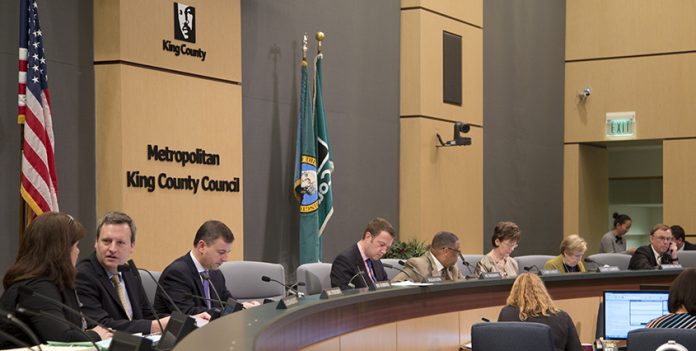“A Broken System” Limits Funding For General Fund, Transit, Housing, and More…
On September 24th, King County Executive Dow Constantine put forth the proposed King County budget for 2019/2020. Lacking the hype that accompanied Mayor Durkan’s first City of Seattle budget, the County’s budget received little media attention and quickly slipped out of the news cycle in the face of other headlines.
However, as an $11.6 billion investment covering more than 60 lines of business, the County budget deserves to be closely scrutinized for how it shapes our region’s transit, health and human services, natural resources, public safety, and justice systems. Its effects are both deeply-felt and far-reaching for the County’s 2.2 million residents.
Unfortunately, the proposed budget also remains a casualty to what the County calls in its Executive Summary a “broken funding system.” The ramifications of revenue shortfalls have already had longstanding consequences on the region and will continue to do so until a more sustainable funding system is achieved.
Two Decades of Chronic Revenue Shortfalls
King County has struggled to maintain services in the face of population growth and inflation. Since 2010, King County’s population has increased from 1.9 million residents to over 2.2 million residents, an increase of 13%. Despite a strong economy, County revenues have not been able to keep up because of revenue collection limitations dating back nearly two decades.
Most revenue collected by the County is restricted in how it can be used by both state law and the King County Charter. For example, revenue generated for Metro Transit, the single largest area of the proposed budget, can only be spent on Metro expenditures. The result is that the King County’s finances are organized into about 140 different funds, each with its own revenue sources and expenditures. Money cannot be transferred between funds when shortages or windfalls occur.
The General Fund is the only truly flexible source of revenue for the county. It supports the traditional services of a county government, including criminal and civil justice functions. The General Fund is primarily funded by a combination of charges for services, property taxes, and sales taxes.
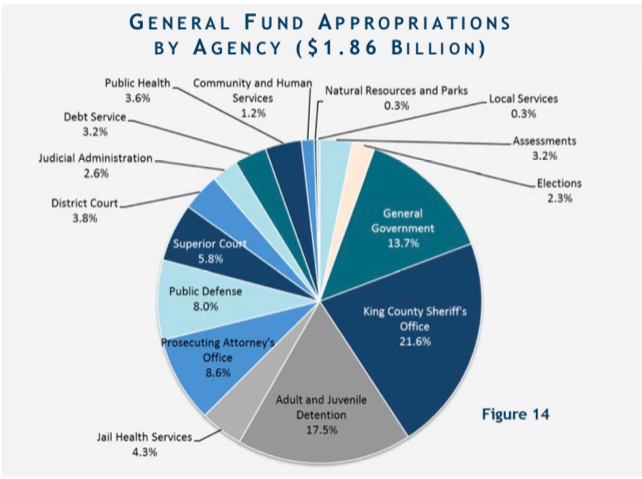
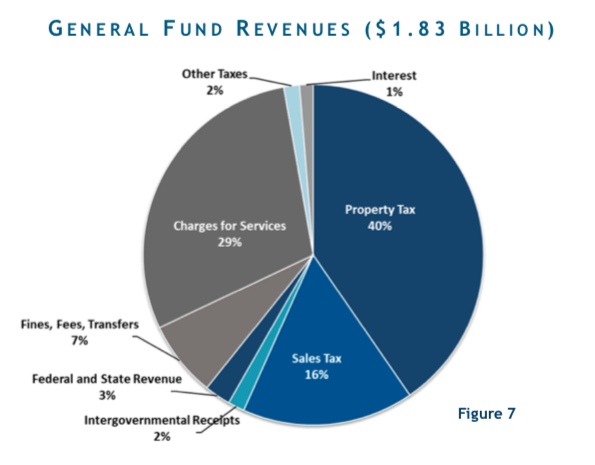
However, both of those systems currently operate with significant flaws.
Limitations on revenue growth to property taxes (capped at 1% per year) has led to a situation called the “structural gap,” in which revenue is unable to keep up with inflation and population growth. For 2019, the structural gap is estimated at $226 million. Voter approved property tax levies have helped to increase funds, but have not come close to covering the difference.
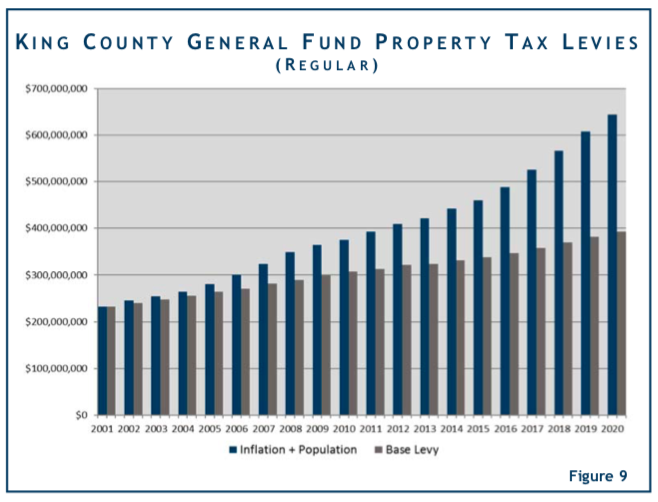
Sales taxes are another area of concern for King County, both for the General Fund and for budget as a whole. In regards to the General Fund, an interesting point is the county’s sale tax problems have resulted in part from the success of the Growth Management Act. Fewer people living in unincorporated areas of King County has meant that vast majority of sales within King County occur within cities, where the the county receives only 0.15 percent of the sales tax collected and the city receives the remaining 0.85 percent, as opposed to unincorporated areas where the County collects the full 1% rate.
Overall, the amount that residents pay into the General Fund per capita has changed very little in 28 years. Removing inflation and property tax levy lids from the equation, in 1990 residents paid an average of $102.95 in taxes to the County’s General Fund. Flash forward to 2017 and the amount was $101.60.
Additionally in regards to the County budget as a whole, sales taxes are not as productive of a revenue tool for the County as they were in the past. The County has experienced an overall marked decline in sales tax revenues that also goes back decades. Changes in buying patterns and income distribution have resulted in the ratio of taxable sales to personal income plunging in King County since 1994.
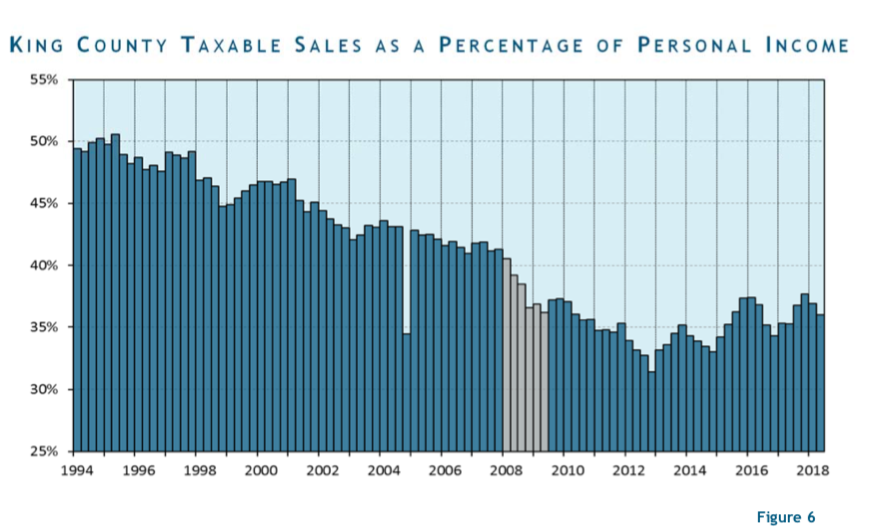
Dow Constantine has vowed to address the “broken system” by “taking the matter to Olympia” and demanding changes to the state law that will allow for King County to collect the revenue it needs to support its services. However, since the situation has remained unchanged for decades, it seems unlikely that significant changes will arise soon.
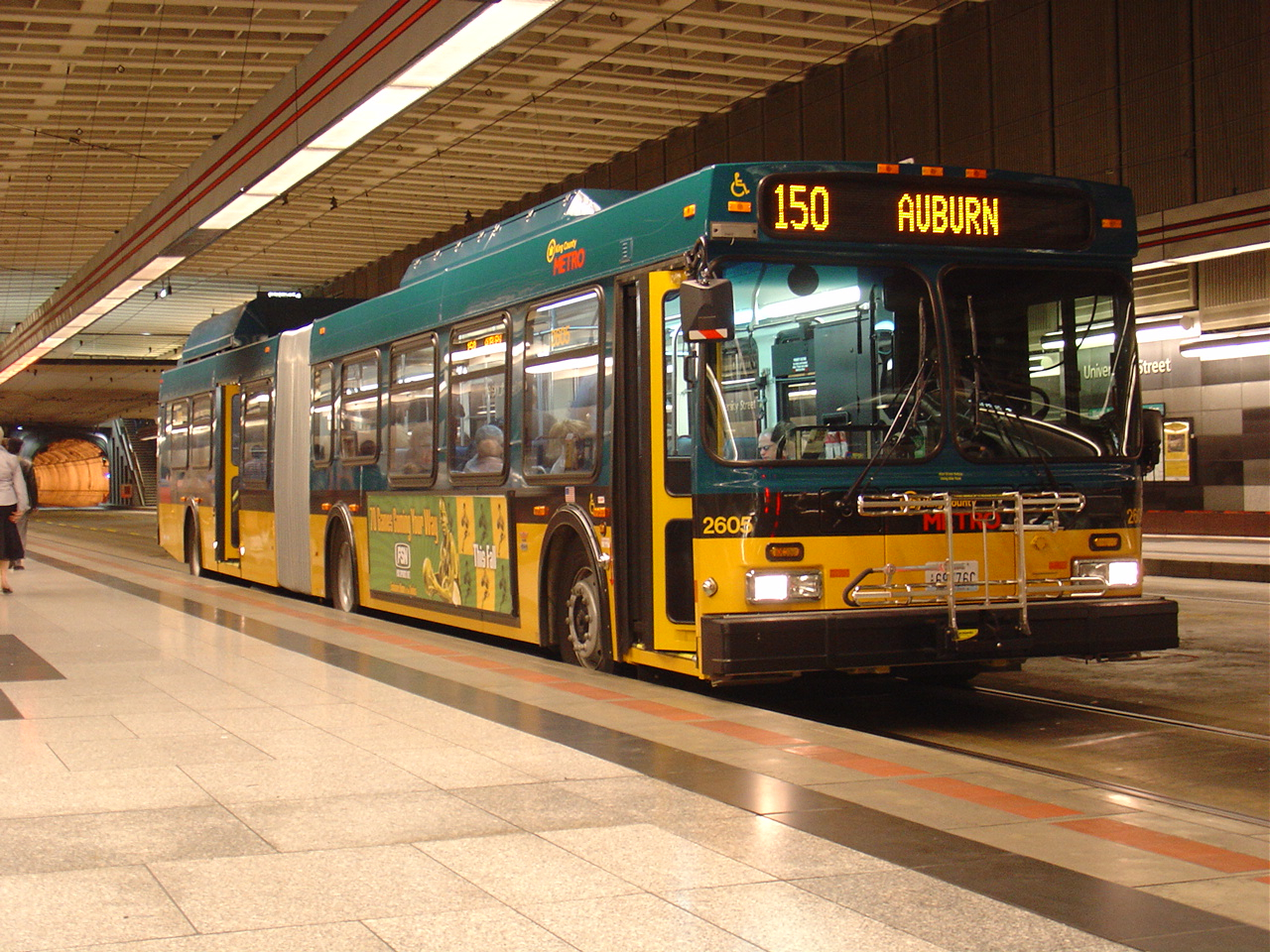
Metro Transit’s Budget Increases, But Fails To Meet Metro Connect’s Goals
As mentioned earlier, Metro Transit expenditures are funded by restricted revenue sources. Because Metro ridership has been growing rapidly for several years, King County has been able to increase its proposed funding in the 2019/20 budget to $2.5 billion, which includes both operating expenses and capitol investment.
However, the proposed $2.5 billion is not sufficient to provide the system and services outlined in Metro Connects, the long-term goals established by King County for transit. For example, three Seattle RapidRide lines orginally expected by 2025 aren’t now and don’t look like they will materialize until a later date.
“Metro has scaled back what they can do realistically,” said Hester Serebrin, Policy Director of Transportation Choices.“It has a lot of capacity constraint and isn’t able to deliver on the Metro Connect goals, which are really ambitious.”
Metro’s current capacity woes are the result of fallout from the 2008 recession. Through 2014, a steep drop in taxes funding Metro forced implementation of austerity measures that made it difficult for Metro to keep up with population growth and service demand.
Increases in revenue in 2017/18, as well projected increases in 2019/20, are allowing Metro to finally make investments in long-term capacity to build its services, including new and expanded bases, layover facilities, information technology, and systems to support the transition to all‐electric buses.
But financial problems may be looming ahead for Metro. Reliant on sales tax to fund approximately 50% of operations, Metro is vulnerable to fluctuations in sales tax revenue, as well as sales tax fatigue among residents. Additionally, the City of Seattle’s transportation benefit district, which supports about 400,000 transit service hours, will expire in 2020–although the City is planning to renew it.
Despite the difficult reality of Metro’s current economic situation, Serebrin has identified some bright spots in the proposed 2019/20 budget, notably in the area of increased engagement with community organizations that represent underserved communities and new programs for low-income riders.
In addition to expansion of ORCA LIFT, a program that provides reduced price transit passes, the County has proposed piloting a very low-income fare program that would operate on a sliding scale, targeting riders who cannot afford ORCA LIFT. “This proposed program resulted from a real understanding of fare evasion,” said Serebrin, “which is that many people simply can’t afford to pay their fare.”
Recognizing the County’s budget limitations, advocacy organizations like Transportation Choices have chosen to focus on small, but impactful measures such as increased funding for safe routes to transit and support of non-motorized access to transit through expansion of bicycle parking at transit sites.
“We’ve had a great time working with Metro on these programs,” Serebrin said. “And we look forward to doing more with our partners there in the future.”
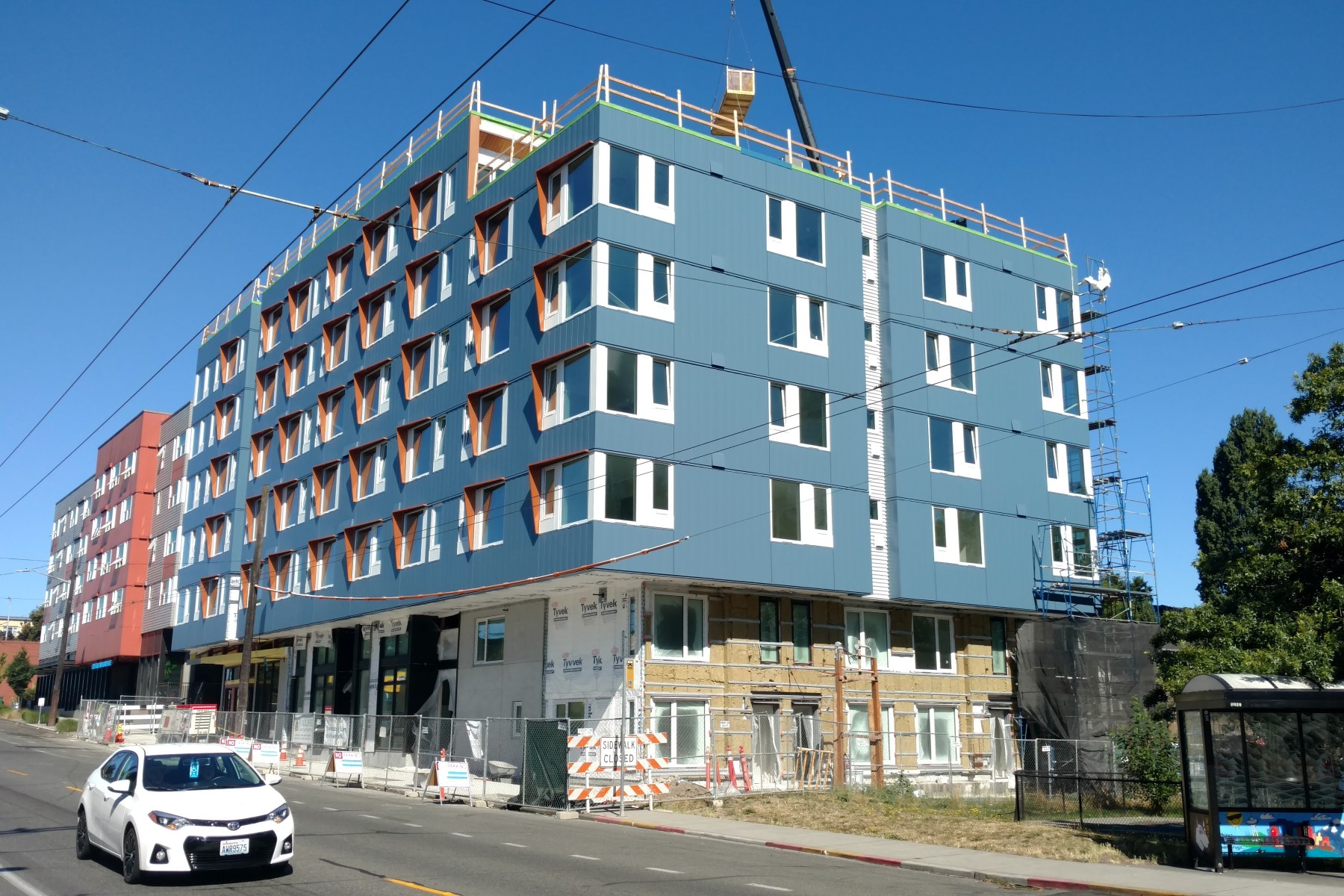
Funding For Housing and Homelessness Remains Inadequate and Contentious
Statistics related to King County’s housing and homelessness crisis continue to shock. The January 2018 Point in Time Count found 12,112 homeless individuals, a 4% increase over the previous year. An independent report released in May by the consulting firm McKinsey and Company estimated that in order to adequately address the homelessness crisis the County would need to increase its current spending to $410 million in order to fund the creation of up to 14,000 housing units affordable for people experiencing homelessness.
When those figures are placed in contrast to the “additional revenue to respond to the challenge of homelessness” listed in the proposed 2019/20 budget, the glaring issue of the County’s inability to raise revenue becomes apparent.
Proposed allocations include an increase in document recording fees that is expected to generate about $10 million for the biennium, a $3 million biennial increase in the State’s Consolidated Homeless Grant, $5 million for affordable housing generated as part of the sale of Convention Place Station, and about $9 million in the biennium from an expansion of the hotel/motel tax. The two latter sources are dedicated to building affordable housing and thus are only indirectly related to homelessness.
While the addition of the $135 million approved for affordable housing by the King County Council in September, brings the County closer to the $410 million target, the funding falls short.
Additionally, affordable housing advocates have concerns about how the money will be spent and how long it will take for funds to be distributed.
“There is simply not enough money in the County budget for permanent supportive housing,” said Sharon Lee, Executive Director, of the Low Income Housing Institute (LIHI). “We do not have sufficient rental housing to meet the needs of people transitioning out of homelessness. I’m very disappointed that the budget does not address pathway for stable housing.”
Lee is also concerned about the slow pace of fund current distribution to nonprofit developers and housing providers.
“In 2018 we have had many different agencies all competing for just $7 million in transit oriented housing,” Lee said. “The current bureaucratic system dribbles out the money too slowly to be effective. We are ready to building affordable housing. The County should be more responsive.”
The County has also prioritized investments in emerging strategies, for creating homeless housing, such as modular housing, instead of investing in strategies that are already being employed by agencies such as tiny house villages and providing support to people living in their cars. According to the most recent one night count, the number of people living in their cars in King Count increased by 46% between 2017 and 2018 alone.
County Seeks Public Comment on Budget Priorities
The County is currently collecting public comments and surveys on the proposed 2019-20. At this time no deadline for public comment has been set, although it is expected that the budget will be finalized by Thanksgiving. To learn more about the budget and submit your feedback, go to the King County Connects website following the link provided here.
Natalie Bicknell Argerious (she/her) is a reporter and podcast host at The Urbanist. She previously served as managing editor. A passionate urban explorer since childhood, she loves learning how to make cities more inclusive, vibrant, and environmentally resilient. You can often find her wandering around Seattle's Central District and Capitol Hill with her dogs and cat. Email her at natalie [at] theurbanist [dot] org.

